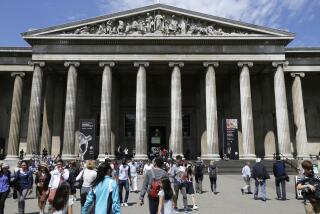The ânewâ Ashmolean
Reporting from Oxford, England â The words âmustyâ and âfustyâ are often trotted out to describe much about Oxford, and not always derogatorily. Visitors who flock to this college town often come in search of the old and tradition-laden: the universityâs famous âdreaming spires,â its medieval chapels, the sight of a student or don in a flowing black gown.
For decades, the universityâs Ashmolean Museum qualified as musty and fusty too. Its treasures, comprising priceless antiquities and artworks, were crammed into heavy wooden display cases set in a series of Victorian-era sheds. Some labels were handwritten in old-fashioned script. The place reeked of academia and serious purpose.
No longer. After a $100-million renovation, Britainâs oldest public museum reopened earlier this month as a bright, airy, modern institution with twice the display space and a design that has drawn near-unanimous acclaim for its marriage of old and new.
Interior reworked
To call it a face-lift would be incorrect: The museumâs imposing neoclassical facade, with its columns and tall double doors, remains intact. But over the threshold lies a gutted, reworked interior that extends surprisingly far back to a 65-foot-high atrium awash in natural light, clustered around which, on six floors, are 39 new galleries, an education center and the cityâs first rooftop restaurant.
âIt gives the museum a new heart and lungs,â one critic wrote, calling the makeover a âgreat achievement.â
Instead of cramped rooms under corrugated metal roofs, the new galleries are spacious and well-lighted, with climate-controlled vitrines and flourishes such as âwindowâ display cases set in the walls that allow visitors to gaze past objects into adjoining rooms with similar items.
Prize holdings
The new layout allows the museum to exhibit more of its impressive permanent collection and to showcase prize specimens, among them a stunning piece of Anglo-Saxon gold known as the Alfred Jewel, after the 9th century king who may have commissioned it; a deerskin mantle, adorned with shells, that belonged to Powhatan, Pocahontasâ father; and the beat-up lantern carried by Guy Fawkes, whose 17th century Gunpowder Plot to blow up Parliament is commemorated every Nov. 5.
The renovation took three years, with the museum closed for the final 10 months. But the genesis of the project harks back even further, as consensus began building that the Ashmolean, beloved though it was by devotees in its somewhat shabby form, needed a major overhaul.
âThere was a very widespread perception that the museum was looking -- how can I put it -- tired,â said Christopher Brown, the Ashmoleanâs director, who came here from the National Gallery in London in 1998. âI didnât quite know when I took the job that it would mean knocking it down and putting it back together.â
The process of choosing a new design led to trips to Shanghai, Thessaloniki in Greece, and other cities to scope out other museums for ideas. Officials also had to navigate the many restrictions on what could be done to buildings tagged by the government for conservation.
âI wanted a contemporary building. Oxford has a taste for pastiche, if you havenât noticed,â Brown said.
None of the alterations is visible from outside at street level, a crucial element of the winning proposal by London-based Rick Mather Architects.
With an extra 100,000 square feet at his disposal, Brown decided to adopt a new thematic approach to displaying artifacts, to help visitors draw connections between different cultures. The ground floor alone, dedicated to the ancient world, boasts items as varied as Chinese paintings, objects from Cyprus and Greco-Roman sculpture, culminating in a towering cast of the god Apollo, up on a platform, in the light-filled atrium.
âIn the past, the collection was always very studied. It was very academic,â said Henry Kim, the project director for the renovation. âNow, the Ashmolean can do something dramatic. You need a bit of drama in museums.â
About the only thing left unchanged, except for some refurbishment, are the galleries containing the museumâs famous collection of paintings, including works by Old Masters and Pre-Raphaelite artists including Titian, Veronese, Rembrandt and Dante Gabriel Rossetti.
This shiny new Ashmolean is merely the latest incarnation of a museum that has reinvented itself several times since it first opened to the public in 1683.
The original collection consisted mostly of natural-history specimens assembled by the Tradescants, a father-and-son gardening team, and was later given to an antiquarian named Elias Ashmole.
What began as âthe Ark,â a sort of curio cabinet, expanded after Ashmole bequeathed the collection to Oxford. In the 19th century, the natural-history items were jettisoned in favor of antiquarian objects, until the collection, grown too big for its original premises, was transferred to its present location in 1845.
It merged with Oxfordâs art galleries on the same site to become what is formally known today as the Ashmolean Museum of Art and Archaeology.
Free entry
Like the great museums of London -- the National Gallery, the Victoria and Albert, the Tate galleries -- the Ashmolean does not charge for admission.
âThe great thing about free museums is that you can sip it. It doesnât have to be a whole dayâs outing,â Brown said. Rather, the museum can become âpart of the way that people every day use the city.â
The renovation, however, cost a pretty penny. Key to the budget was a $25-million handout from the national lotteryâs heritage fund; the rest came from private donors -- not an easy amount to raise through a global recession.
More to Read
Sign up for The Wild
Weâll help you find the best places to hike, bike and run, as well as the perfect silent spots for meditation and yoga.
You may occasionally receive promotional content from the Los Angeles Times.







